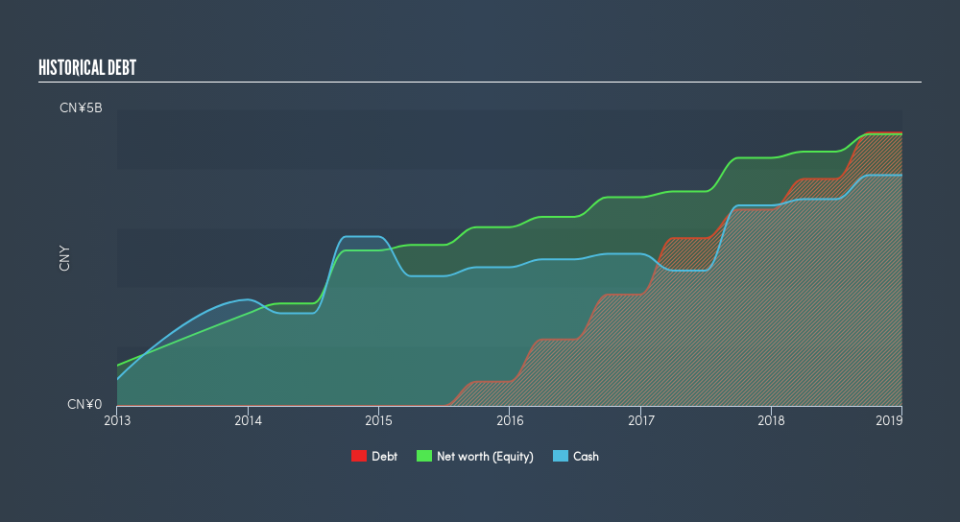Is Beijing Urban Construction Design & Development Group (HKG:1599) Using Too Much Debt?

Howard Marks put it nicely when he said that, rather than worrying about share price volatility, 'The possibility of permanent loss is the risk I worry about... and every practical investor I know worries about.' So it seems the smart money knows that debt - which is usually involved in bankruptcies - is a very important factor, when you assess how risky a company is. As with many other companies Beijing Urban Construction Design & Development Group Co., Limited (HKG:1599) makes use of debt. But should shareholders be worried about its use of debt?
What Risk Does Debt Bring?
Debt assists a business until the business has trouble paying it off, either with new capital or with free cash flow. If things get really bad, the lenders can take control of the business. While that is not too common, we often do see indebted companies permanently diluting shareholders because lenders force them to raise capital at a distressed price. Having said that, the most common situation is where a company manages its debt reasonably well - and to its own advantage. The first step when considering a company's debt levels is to consider its cash and debt together.
Check out our latest analysis for Beijing Urban Construction Design & Development Group
What Is Beijing Urban Construction Design & Development Group's Debt?
As you can see below, at the end of December 2018, Beijing Urban Construction Design & Development Group had CN¥4.61b of debt, up from CN¥3.31b a year ago. Click the image for more detail. However, it also had CN¥3.89b in cash, and so its net debt is CN¥714.0m.
How Strong Is Beijing Urban Construction Design & Development Group's Balance Sheet?
According to the last reported balance sheet, Beijing Urban Construction Design & Development Group had liabilities of CN¥7.32b due within 12 months, and liabilities of CN¥4.50b due beyond 12 months. Offsetting this, it had CN¥3.89b in cash and CN¥5.88b in receivables that were due within 12 months. So it has liabilities totalling CN¥2.05b more than its cash and near-term receivables, combined.
This is a mountain of leverage relative to its market capitalization of CN¥2.49b. Should its lenders demand that it shore up the balance sheet, shareholders would likely face severe dilution.
In order to size up a company's debt relative to its earnings, we calculate its net debt divided by its earnings before interest, tax, depreciation, and amortization (EBITDA) and its earnings before interest and tax (EBIT) divided by its interest expense (its interest cover). The advantage of this approach is that we take into account both the absolute quantum of debt (with net debt to EBITDA) and the actual interest expenses associated with that debt (with its interest cover ratio).
Beijing Urban Construction Design & Development Group has net debt of just 1.2 times EBITDA, suggesting it could ramp leverage without breaking a sweat. But the really cool thing is that it actually managed to receive more interest than it paid, over the last year. So there's no doubt this company can take on debt while staying cool as a cucumber. Also good is that Beijing Urban Construction Design & Development Group grew its EBIT at 13% over the last year, further increasing its ability to manage debt. When analysing debt levels, the balance sheet is the obvious place to start. But ultimately the future profitability of the business will decide if Beijing Urban Construction Design & Development Group can strengthen its balance sheet over time. So if you want to see what the professionals think, you might find this free report on analyst profit forecasts to be interesting.
Finally, while the tax-man may adore accounting profits, lenders only accept cold hard cash. So the logical step is to look at the proportion of that EBIT that is matched by actual free cash flow. Over the last three years, Beijing Urban Construction Design & Development Group saw substantial negative free cash flow, in total. While investors are no doubt expecting a reversal of that situation in due course, it clearly does mean its use of debt is more risky.
Our View
Neither Beijing Urban Construction Design & Development Group's ability to convert EBIT to free cash flow nor its level of total liabilities gave us confidence in its ability to take on more debt. But the good news is it seems to be able to cover its interest expense with its EBIT with ease. Taking the abovementioned factors together we do think Beijing Urban Construction Design & Development Group's debt poses some risks to the business. While that debt can boost returns, we think the company has enough leverage now. Another positive for shareholders is that it pays dividends. So if you like receiving those dividend payments, check Beijing Urban Construction Design & Development Group's dividend history, without delay!
If you're interested in investing in businesses that can grow profits without the burden of debt, then check out this free list of growing businesses that have net cash on the balance sheet.
We aim to bring you long-term focused research analysis driven by fundamental data. Note that our analysis may not factor in the latest price-sensitive company announcements or qualitative material.
If you spot an error that warrants correction, please contact the editor at editorial-team@simplywallst.com. This article by Simply Wall St is general in nature. It does not constitute a recommendation to buy or sell any stock, and does not take account of your objectives, or your financial situation. Simply Wall St has no position in the stocks mentioned. Thank you for reading.


